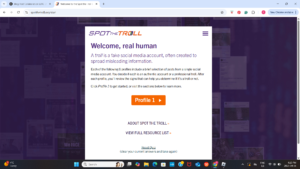Teaching Digital Literacy Through Critical Thinking: My Experience with “Spot the Troll”
Teaching Digital Literacy Through Critical Thinking: My Experience with “Spot the Troll”
As a future educator—and also a mom—I often think about how much time young people spend online. With social media and AI growing so fast, it’s harder than ever to tell what’s real and what’s not. That’s why I feel it’s so important to talk about digital literacy in the classroom.
🔍 My Personal Experience with Spot the Troll
This week, I tried an online quiz called Spot the Troll. It shows real and fake social media profiles and asks you to figure out which ones are created by trolls. I did Profile 7—and I actually guessed it right!
🖼️ Screenshot: My experience with Spot the Troll – helping students think critically about online content.
One quote from that profile said: “Evil is powerless, if the good are unafraid.”
It really stayed with me. It sounded so powerful and real, and I was amazed how easily we can believe something just because it feels strong or emotional.
This made me realize how important it is to talk to students about not believing everything they see online. I’d love to use this in my own class, maybe even by sharing my own example.
🔬 Digital Literacy in Science Class
Since I come from a science background, I see a strong connection between inquiry-based learning and digital skills. When students do research—whether it’s about climate change or Earth’s resources—they need to know how to find reliable information.
In Grade 7 Science, for example, we cover Outcome EC7.2 from the Saskatchewan Science Curriculum. This outcome asks students to:
“Identify locations and processes used to extract Earth’s geological resources and examine the impacts of those locations and processes on society and the environment.”
To meet this outcome, students often explore articles, websites, news reports, and videos to research real-world examples. This creates a perfect opportunity to teach digital literacy skills, such as:
-
Evaluating the credibility of websites
-
Recognizing bias in environmental or corporate reporting
-
Fact-checking sources using tools like Break the Fake or the Media Bias Chart
By embedding these practices into inquiry projects, we ensure students aren’t just gathering information—they’re learning how to think critically about the information they find online.
🌍 How It Connects with the NCTE Framework
What I did this week also connects to parts of the NCTE Framework, like:
-
Learning to question what we see online
-
Understanding bias and responsibility when we share info
-
Using tech to think deeply and critically
This shows that digital literacy isn’t just a tech skill—it’s part of how we think, learn, and grow in the modern world.
💬 Final Thoughts
Teaching kids to spot fake news is not something that should wait until high school. They are already online. They already see posts and videos that influence their thinking.
Using tools like Spot the Troll helps bring these conversations into the classroom in a real and personal way. I think students will relate more if I share my experience, including how I felt proud, surprised, and curious.
We don’t just want kids to use the internet—we want them to be smart and thoughtful online.


I agree! It’s extremely important to be teaching all people digital literacy and fake news. It should be introduced in elementary school as that’s the average time for children to start getting online!